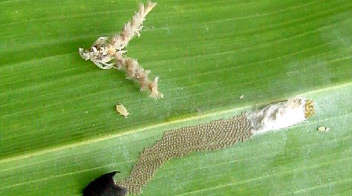
Insect Life CycleIASZoology.com
Life Cycle of Sugarcane Pyrilla
Host: This insect is a serious pest of sugarcane in northern India where it also occasionally feeds on maize, millets, rice, barley, oats, sorghum, bajra and wild grasses.
Damage: The pest is found gregariously on the under surface of the leaves where they suck up plant sap that causes yellowing and eventually drying of leaves. Under low infestation yellow patches appear on the leaves. Photosynthesis is reduced resulting in the reduction of sucrose content of the juice by up to 30%. Hoppers secrete a sweet substance called honey dew that coats the leaves and attracts a blackish fungus, which reduces photosynthesis resulting in yield loss.
Life cycle: Adult hoppers are straw coloured to brownish, 7-8 mm long, with a pointed snout bearing piercing and sucking mouth parts. They are found gregariously and jump off readily when disturbed. Adults are active fliers, migrating from one crop to another and breed throughout the year. Eggs are light yellowish in colour, oval, one mm long and laid on the lower surface of the leaf, near the midrib in groups of about 20 eggs, which hatch in 6-15 days depending on temperature.
Nymphs are initially greenish, later turn pale brownish, wingless and with a pair of anal filaments covered with whitish fluffy waxy material. There are 5 nymphal instars which take 40-60 days to complete development. Multiplication of the pest is favoured by high humidity and luxuriant plant growth as in heavily manured and irrigated field or in rainy season.
Distribution: The pest is found throughout the Indian subcontinent from Afghanistan to Burma and Thailand.
Control: Spray Chlorpyriphos 20.00% EC @ 600 ml or Monocrotophos 36.00% SS @ 200 ml per acre with 200 liters of water.
Egg parasitoids:Tetrastichus pyrillae, Cheiloneurus pyrillae, Ooencyrtus pyrillae, O. pipilionus, Agoniaspis pyrillae.
Nymphal parasitoid: Lestodryinus pyrillae, Pyrilloxenos ompactus, Chlorodryinus pallidus.
Predators: Coccinella septempunctata, C. undecimpunctata, Chilomenes sexmaculata, Brumus suturalis.
Source: - IASZoology.com
If you find this information useful, like it and share it with your friends.
19
6

